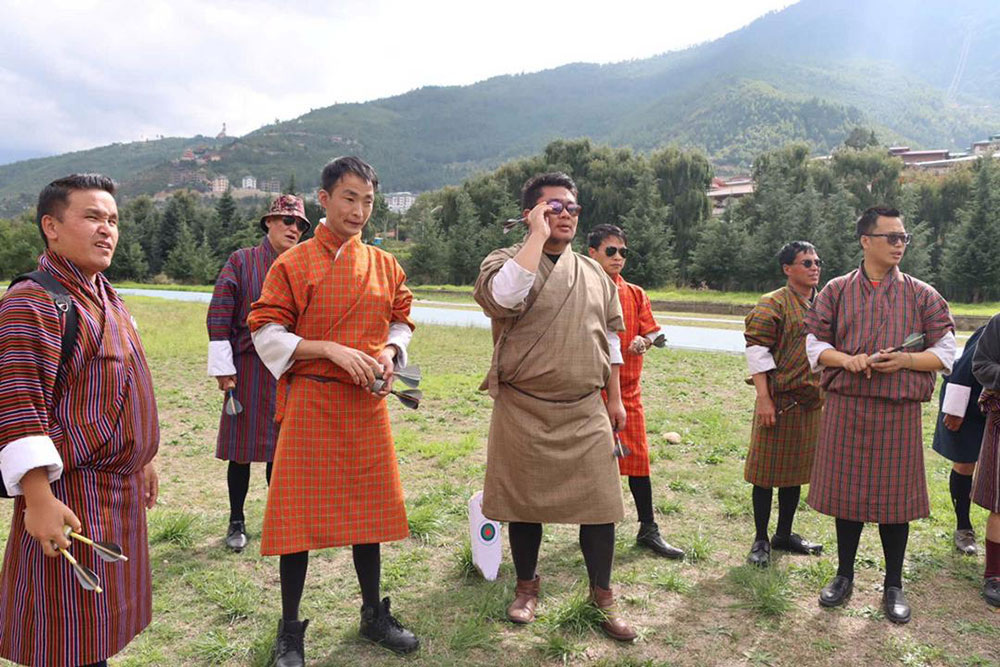Our reporter Yangyel Lhaden joins the event to immerse herself in the significance of the Day
Yangyel Lhaden
In the quiet early hours of Sunday morning, Thimphu seemed to be in deep slumber. The town was enveloped in a tranquil aura, with few people and thin traffic. Shops were still shuttered, and the cool autumn breeze whispered through the streets. But amidst this calm, something remarkable was unfolding at the very heart of the Clock Tower.
At 9:15am, a cheerful man makes his way through the growing crowd and greets them with the traditional Bhutanese salutation, “Tashi Delek, Dari Gi Nyim Lu!” All eyes turn towards him, intrigued by his presence. He playfully challenges the crowd, “Can you guess who I am?” A voice from the onlookers quickly replies, “You’re our Thinley. How could I ever forget your voice?”
One by one, persons with visually impairment begin to make their way towards the center of the Clock Tower, accompanied by their keepers. Some walk with partners, others are surrounded by friends and family. Laughter and the pulse of life reverberate through the heart of the town as Thimphu slowly stirs from its slumber.


The participants use sound cues to hit the target
These people have gathered here for a purpose greater than a casual meet-and-greet; they are here to commemorate International White Cane Safety Day at the iconic Clock Tower in the heart of the capital.
White Cane Safety Day, established in 1964 by US President Lyndon B. Johnson, aims to raise awareness about individuals who rely on the white cane for their mobility.
The day’s plan is simple yet powerful: participants will first gather at the Clock Tower, then pair up and embark on walks in opposite directions around the town. Their destination: the Athletic Ground at Lungtenzampa. Here, they will engage in games and share a meal.
For those who do not have a white cane, bamboo canes are being provided as an alternative. The cost and availability of white canes is an issue, which cost around Nu 1,800 and is available only in one medical store in Thimphu.
One gentleman reminds the keepers, “Make sure you take care of your loved ones. Ensure that they reach their destination safely and without any injuries.”
As the groups set off to walk around town, advocating for the importance of the white cane as a symbol of independence for the blind, the sun begins to break through the morning gloom. The town’s traffic police are actively supporting and escorting the groups to guarantee the success of their walk.
Bystanders gaze in wonder at the marching group. The traffic police take on the role of ensuring safe crossings. However, among the onlookers, a comment catches the group’s attention: “Run! Run!”
A person with blindness mutters, “It is very insensitive to say such things when we are walking to advocate for our rights.”
“Watch out!” cautions a keeper. “There is a large hole between the footpaths.” The group proceeds cautiously, relying on their white cane to detect any potential obstacles. They skillfully navigate around the hole and continue their journey.
Sangay, a young child, is her mother’s keeper today. As her mother walks straight towards a pole, she is fixated on a traffic police mannequin placed on the balcony of the traffic office.
“Bumo! Watch out; your mother is walking towards the pole,” a voice cries. “Don’t worry; I have a white cane with me, and it will alert me to obstacles,” says Sangay’s mother.
At 12pm the participants have reached the Athletic Ground. Here, they deliver powerful speeches on the significance of the white cane, share a communal lunch, and engage in a spirited game of khuru. The participants use sound cues to hit the target.
Among the participants, one keeper stands out—68-year-old Dem, who is accompanying her son in his 40s, Sangay Rinchen, who works as a musician in a five-star hotel.
“I came here to enjoy and observe today’s event,” said Dem. Says Sangay Rinchen with a smile, “Even though my mother won’t admit it, I know she is here because she still cares about me.”
Dem may not agree, but their presence at this remarkable event speaks volumes about the bond between keepers and those they care for, and the strength of the Bhutanese community as they advocate for the rights and independence of individuals with visual impairments.


